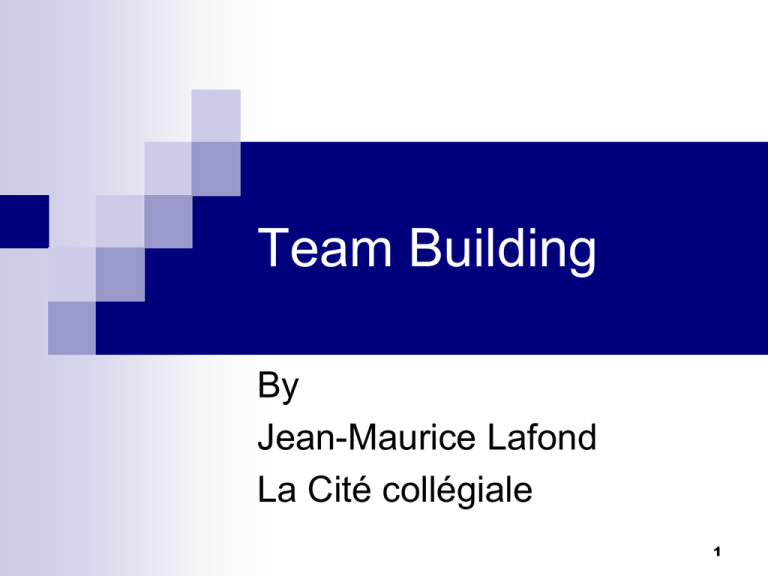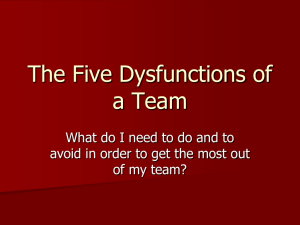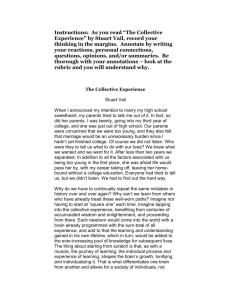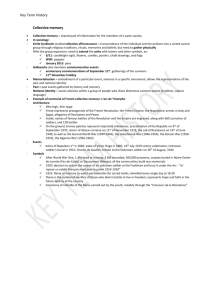Jean-Maurice Lafond: Team Building
advertisement

Team Building By Jean-Maurice Lafond La Cité collégiale 1 Who are you? What’s your name? Where are-you from? What are-you doing here? 2 3 Session’s content 10h45 Presentation, Introduction, the model: From the Five W’S: Why, What, Who, When and Where 11h Why and What 11h15 Who, When and Where 11h30 And How: 8 common approaches 11h45 And How: Communication and activities 12h Break 12h15 Your story: examples of team work that supported faculty or students success 12h30 Learning's and Conclusion 12h45 Evaluation 4 Who Team Building Five W’s 5 And How 6 Team Building Five W’s 7 Why Team Building? We want to move from individual to collective accomplishment. We want to provide a unique social dimension that enhanced work. We want to have fun together (work, performance, parties, celebrations). We want to motivate, challenge, reward and support individuals who want to be part of something larger. 8 Why team work Because we are facing a situation requiring the real-time combination of multiple : Skills Experiences and Judgments 9 Team Building Five W’s 10 What is a team? Vs Group of colleagues 11 What is Building? 12 What is Team Building? 13 We build a team by … Focusing on performance and team basics as opposed to trying “to become a team”. Performance = any recognized accomplishment Performance: The results of activities of an organization or investment over a given period of time. « An ounce of performance is worth pounds of promises. » Mae West 14 Again, what is a team? A small number of people With complementary skills Who are committed to a common purpose Common performance goals and common approach For which they hold themselves mutually accountable. 15 A common purpose “A joint creation that will exists only because of the team’s collaborative effort.” That they own and can translate into specific actionable goals. That give identity, pride and responsibility. 16 Common performance goals Specific and measurable goals That will allow the team to achieve small and big wins as it pursues its purpose. 17 Complementary skills Technical or functional expertise Problem solving and decision making skills Interpersonal skills 18 Common approach How they will work together to accomplish their purpose: Common approach Economic aspects Administrative aspects Social aspects 19 Mutual accountability Commitment Trust For performance and joint results 20 Team work Moving beyond individual roles and accountability. Taking responsibility for the performance of others. Letting others assuming responsibility for us. 21 Team Basics 22 Becoming a team To a high-performing team Real team Potential team Pseudo-team From a working group 23 Four steps Team members Step 1 Formation Step 2 Storm Performance goals Step 3 Acceptation Step 4 Performance 24 Who Team Building Five W’s 25 Who should be part of the team? Selection of team members based on skills and skills potential. People motivated by the common purpose. People ready for hard work and good fun. People who want to be part of something larger than themselves. People who want to change the way they do things. People who really do want to make a difference. 26 Team Building Five W’s 27 When team building is the thing? When we are facing significant performance challenges. We need multiple skills, judgments and experiences. We have a clear mission: Recommend things To make or to do things To run or manage things 28 Team Building Five W’s 29 Where? In the office Out of the office In the field First meeting Following meetings Conflict management Last meeting Celebration 30 Feedback … On the five W’s Situation in our organization and job 31 And How? Team Building: 8 common approaches Team Building through Communication and Activities 32 Common approaches 1. 2. 3. 4. Establish urgency and direction Focus on skills and skills potential Pay attention to first meetings and action Set clear rules of behavior 33 Common approaches 5. 6. 7. 8. Set and seize upon a few immediate results Challenge the team with fresh facts and info Spend time together Exploit the power of positive feedback, recognition and collective rewards 34 Team Building through Communication Communication in the center of Team building and Team work Active listening Art of asking questions Art of giving feedback Having effective meetings Empowering others 35 Active listening The capacity to Focus your attention on the subject Listen closely without judging Acknowledge any emotional state Repeat Paraphrase Summarize In order to check for accuracy of understanding. 36 Active listening In order to understand the speaker’s Ideas Problems and Emotions Expressed either verbally or non verbally Seeing things from the speaker’s point of view (empathy). 37 Art of asking questions State The Point Of Your Question Open-ended Questions For Information "Where can we cut costs in this process?" Closed-Ended Questions For Agreement "I am trying to find ways to cut some operating costs, so that's why I need to know about what we spent on that last project." "So, do you feel comfortable moving ahead on the project?" Ask "Why" Questions With Care Ask Positive Questions Make Sure That Your Body Language Encourages An Answer 38 Art of giving feedback Owned (‘I’ not ‘we’) NOT Implied Planned NOT Impulsive Honest NOT Collusive Valid NOT Irrelevant (c.f. shared agenda) Concerned NOT Destructive Specific NOT Vague Behaviour NOT Person 39 Art of giving feedback Observation NOT Inference Sooner NOT Later Descriptive NOT Judgemental Sharing ideas NOT Giving advice Exploring alternatives NOT Providing answers Good things NOT Only bad things 40 Art of giving feedback Feedback should be used: At the right time At the right dose With clarity and accuracy When indicated 41 Having effective meetings Regular Planning, Organizing, Holding, Leading, Evaluating the meeting, Producing notes and managing follow-ups. Choosing different techniques: Gap analysis, brain storming, problem solving Scrum meetings short, daily meetings designed to keep teams on track and help members get their work done 42 A Gap Analysis = Empowering others Questions: Where are-you and where do you want to be? What would it take to get from here to there? What action steps would you need to put in place? How will you monitor your progress? How will you evaluate what you have accomplished? How can I help? 43 Team Building through Activities 44 Quick Team Building activities for busy Coordinators Step 1, Before: Start with a clear objective in mind. Some examples: Communication: Getting to know each other. Cooperation: Working together as a team. Coping: Dealing with change and conflict. Creativity: Solving problems together. Team work: Appreciating and supporting each other. Step 2, Before: Select an activity that’s good for your team. Step 3, Before: Prepare the activity. 45 Quick Team Building activities for busy Coordinators Step 4, During: Explain the activity, rules and expectations and check for understanding before beginning. Step 5, During: Run the activity. Step 6, During: Debrief the activity. Step 7, After: Reinforce the learning back on the job. 46 Feedback … On How … 47 Tell your story: examples of team building or team work Background The Performance Challenge How everything started How did it go What was the results (economics, administrative, social) 48 In Conclusion Your conclusion on team work, team building and our job. My conclusion … My references … 49 In Conclusion In a world of individualism and strong personalities, Team work and team building can revitalize departments and encourage faculty to take risks and make experiments. Team work can produce performance results, collective accomplishments and personal growth if we have skills, commitment and accountability. Team building can be fun, simple, rewarding and productive. Thank you. 50 References Jon R. Katzenbach, Douglas K. Smith, The Wisdom of Teams, Harvard Business School Press, 1993 Ann F. Lucas, Strengthening Departmental Leadership, JosseyBass Publishers, 1994 Solange Cormier, La communication et la gestion, Presses de l’Université du Québec, 1995 Brian Cole Miller, Quick Team-Building Activities for Busy Managers, American Management Association (AMACOM), 2004 51











